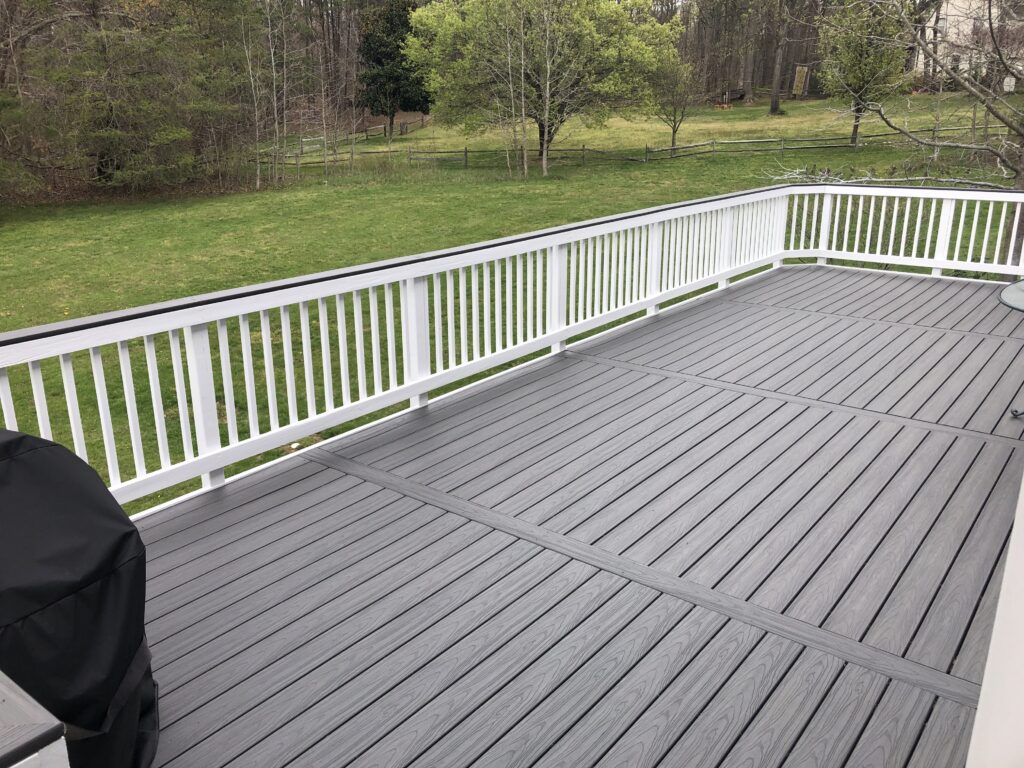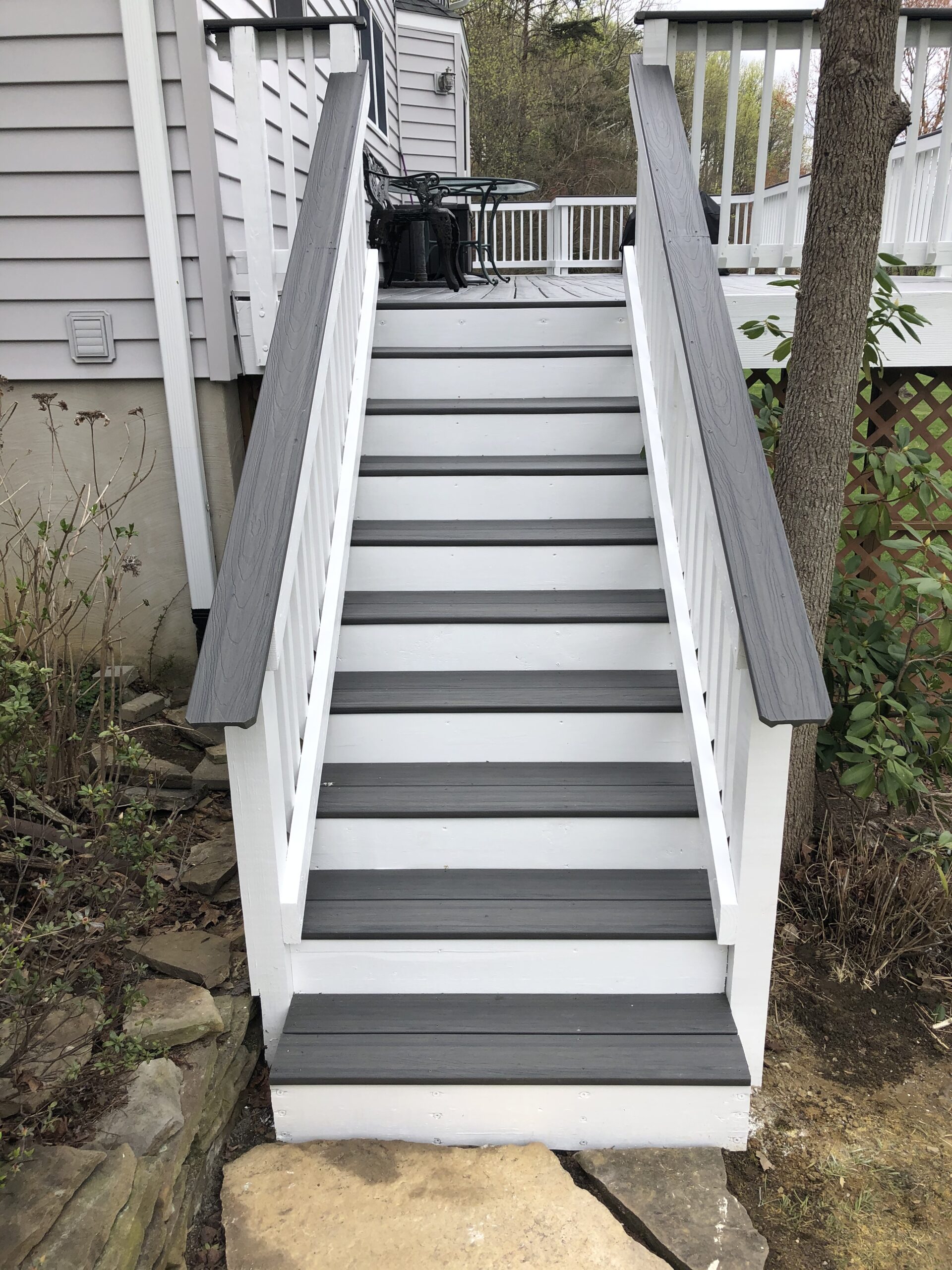



Composite Deck Builders
in Annapolis
Want a low maintenance composite deck in leu of wood? We can help you with a wonderful deck design that’s easy to maintain and durable.
If you’re interest in a low-maintenance option for your outdoor deck below is a list of fun facts and items to know and consider when choosing the details of how your new modern deck is constructed.
About Composites
Since the introduction of Trex’s first “timber-alternative deck board in the early 90’s, composites have evolved and changed in design and detail. Over the years, there have been a multitude of manufacturers that have worked to get their foot in the door and create products to compete in this building materials space. The best known of course is Trex, because they were the first or at least the first to really get the idea in motion with their original gray composite deck board. Since then, the use of composites, plastics, metals and non-wood products have taken the market and really changed the shape and shade of outdoor living spaces.
What is Composite Decking?
Composite decking is composed of a combination of recycled plastics, wood grain fillers, and various binding agents (glue) to hold it all together. If comparing to PVC decking the composite deck boards have a larger range in price, they are heavier than PVC, but you have a wider rang of colors and textures.
What Is a "Capped" Deck Board?
Basically, a capped composite deck board has a plastic coating on at least the top side of the board that is stamped with usually a wood-grained impression. These caps can have colors of all types and patterns to resemble real wood. This cap protects the composite mixture of materials within, keeping them from becoming porous and absorbing moisture. Another benefit to the “cap” is that the Sun’s UV rays don’t get a chance to penetrate the organic material within making it brittle. The original Trex decking board did not have a cap and like I said earlier, these boards have been known to absorb moisture, swell and loose some of their top layers.
What is PVC Decking?
PVC decking is decking made from polyvinyl chloride (a type of plastic), with no organic material such as wood pulp or saw dust. Because there’s no organic material, PVC will not absorb moisture. Because it does not absorb moisture, there is no degradation from water and freeze/ thaw cycles. Is PVC really better? That depends on the situation and most deck builders agree that a good modern “capped composite” deck board will suite the need just fine and last as long as the frame it sits on. PVC boards have a slightly different look and feel and the way they heat up and cool down is slightly different than capped composites. We can explain more and help you navigate the road to getting your dream deck with an in-home consultation with our deck expert.
Another difference between wood decking and composite or PVC is temperature! You must know that all non-wood deck boards can feel more “HOT” to be on in direct sun than wood and thats a fact no deck builder will counter. It’s simply the fact that wood dissipates heat better because of what it is. Unstained pine deck boards will be the coolest temperature in direct sunlight because their cellular structure within the wood fibers. Composites and plastics are dense and do not “breathe” so to speak, leaving you with a material that sometimes seems to just want to KEEP HEATING UP with the overhead sun. This is one reason to choose wisely, especially if your deck faces south and you think you’ll be out on in during the middle of the day during the summer months. Of course angles to the sun matter and this topic really only applies if you are not in the shade from trees of structures covering the deck.
Regarding temperature, choosing wisely often means CHOOSING THE RIGHT COLOR composite deck board because this plays a dramatic role in how the material will heat up in the direct sunlight. How to get a color that’s safe? It’s pretty simple really, the darker the board, the hotter it CAN get. Colors such as light gray and light brown are going to do pretty good and shouldn’t feel too much hotter than a pine wood deck with a medium-intensity semi-transparent stained finish. On the contrary, dark browns and reds are going to be little ovens on your feet at high noon in July.
Please watch my video Here: to see how composites compare in direct sunlight using a heat gun.
Do Composite Deck Boards Get Too Hot in The Summer?
Speaking of composite or “Low maintenance” decks, how is the frame constructed?
The short answer is that it’s constructed with pressure treated pine wood. There is no way to build a composite deck without some sort of Non-composite frame system and although there are metal framing materials coming on the scene in recent year, here in the north east of USA currently, almost exclusively, we build with wood. The deck frame is constructed first then all of the non-wood materials (railings, trim and decking) are added. In regards to the framing technique, there are some differences in how the frame is constructed compared to an all-wood deck. For example, the spacing of the joist is usually tighter with spacings closer to 12” for composites, than 16” with wood. This is just an example, and there are more intricate framing details to a composite deck and this is another reason why they are more expensive to build.
Trim: The Finishing Touches
A nicely trimmed deck is wonderful and adds a real finishing touch that will set apart one deck to another. This comes with a cost of course, as PVC trim is expensive and difficult to work with. PVC is what is most commonly used and the brand that most are familiar with is called “Azek”. Azek and other PVC trim is found not only on decks, but is often used for rake boards and around windows on homes with low-maintenance exteriors. PVC can also be tricky to install in a way that does not move or remove itself with time. The material expands and contracts tremendously with temperature making it temperamental. It must be installed correctly or will often come loose. This is a common problem and we frequently get calls from customers that have had a trim board or two completely fall off—not our jobs of course! A good installation of PVC trim requires the proper use of screws spaced appropriately per the manufacturers’ recommendation.
Fasteners: What is best for my composite deck?
Fasteners; what is the best for my composite deck?
There are a multitude of options now for how your deck boards may be fastened to the frame. We are familiar and have used all options available and though thoughts may vary, we have our preferences depending on which deck board we are installing. Some fastening techniques work for certain deck boards, while other screws or clips will not work for another. For example, if we are installing certain PVC deck boards, we prefer using stainless steel face screws with a composite plug to cover the hole. This method would not be ideal for all decking boards, so what we recommend is that we first help you choose the board you like, then we’ll find the best fastener for that application. One thing is for certain, you never want a deck board to move around or stick up creating a trip hazard or unsightly joint.
Pattern “deck-board-layout”
The Design of the deck can be dramatically improved by using a positive deck board layout. “Deck-board-layout” is the way we stagger joints, angle the boards, picture frame the deck, break the deck into usable sections and so on. Each deck we build or re-build is unique in its shape and size, and therefore thought must be put into planning the floor boards so that: A. The material is used in an efficient manner to cause little waste (which directly relates to cost.. ultimately for you the homeowner) and B. Looks good and has the right flow. We look at the overall picture, and plan this with you, as part of the deck designing process. We will look at where doors and windows are on the house also as reference points so that we don’t end up with something “odd” or uneven, if at all possible.
Picture framing is a popular way to enhance the look and feel of a deck, but there are also other factors to consider when choosing the deck-board-layout such as where the board end-joints will fall and how long the runs are, the size of the deck and where the steps will land. One thing to know is that most composite deck boards usually are available in 12, 16 or 20 foot lengths only. Choosing the correct size boards is something that our team will take care of, but it can limit what is practical when designing the overall shape of the deck.
